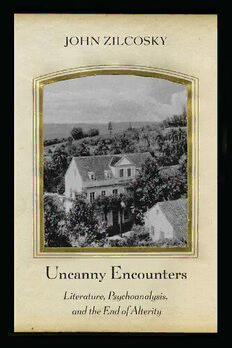
Uncanny Encounters: Literature, Psychoanalysis, and the End of Alterity PDF
Preview Uncanny Encounters: Literature, Psychoanalysis, and the End of Alterity
Uncanny Encounters Uncanny Encounters Literature, Psychoanalysis, and the End of Alterity John Zilcosky northwestern university press evanston, illinois Northwestern University Press www .nupress.northwestern.edu Copyright © 2016 by John Zilcosky. Published 2016 by Northwestern University Press. All rights reserved. Portions of some chapters have appeared earlier in different form: “Unheimliche Begegnungen: Abenteuerliteratur, Psychoanalyse, Moderne,” in Literarische Entdeckungsreisen: Vorfahren— Nachfahrten— Revisionen, ed. Hansjörg Bay and Wolfgang Struck (Weimar: Böhlau, 2012); “Savage Science: Primitives, War Neurotics, and Freud’s Uncanny Method,” American Imago 70 (Fall 2013); and “Hermann Hesse’s Colonial Uncanny: Robert Aghion, 1913,” New German Critique 41 (Fall 2014). Permission to reuse this material is here acknowledged. Printed in the United States of America 10 9 8 7 6 5 4 3 2 1 Library of Congress Cataloging- in- Publication Data Zilcosky, John. Uncanny encounters : literature, psychoanalysis, and the end of alterity / John Zilcosky. pages cm. Includes bibliographical references and index. ISBN 978-0-8101-3210-8 (cloth : alk. paper) — ISBN 978-0-8101-3209-2 (pbk. : alk. paper) — ISBN 978-0-8101-3211-5 (ebook) 1. German literature—20th century—History and criticism. 2. Uncanny, The (Psychoanalysis), in literature. 3. Travelers’ writings, German—History and criticism. I. Title. PT405.Z54 2015 830.90091—dc23 2015031421 For Rebecca, Charlie, and Nora Contents List of Illustrations ix Acknowledgments xiii Abbreviations and Note on Translations xv Introduction: Uncanny Encounters 3 Chapter 1 Germans in the Jungle: Hot Land and Tales of Adventure 29 Chapter 2 Europe in India: Hermann Hesse and the East 51 Chapter 3 Savage Freud: Primitives, Adventurers, and the Uncanny Method 77 Chapter 4 Exotic Europe: Modernist Ethnographies (Mann, Hofmannsthal, Musil) 125 Epilogue: Toward a Theory of Uncanny Violence 165 Notes 183 Works Cited 227 Index 249 Illustrations 1. Map of the family’s settlement from the 1816 English edition of The Swiss Family Robinson (close likeness of the map from the original 1812–13 German version)— dubbed “New Switzerland” in later editions (courtesy of University of Florida, Baldwin Library of Historical Children’s Literature) 4 2. Map of Treasure Island, from the first book edition of Treasure Island (1883) (courtesy of the Thomas Fisher Rare Book Library, University of Toronto) 5 3. Map of Crusoe’s Island, first published in Serious Reflections During the Life & Surprising Adventures of Robinson Crusoe, a 1720 sequel to Robinson Crusoe (1719) (courtesy of the Thomas Fisher Rare Book Library, University of Toronto) 6 4. Map of Africa, whose emptiness is filled with an elephant, exotic birds, and a Cyclops (from Sebastian Münster’s Cosmographia [1544]) 7 5. Section of Willem Blaeu’s “Nova Africa” map (1617), featuring lions, elephants, a monkey, a crocodile, and, along the coast, fabulous sea creatures 8 6. Typical Enlightenment map of Africa (1749), with the interior left blank (by Jean- Baptiste Bourguignon d’Anville) 9 7. An 1875 map of Africa, where the middle is still relatively blank— marked unerforscht (uncharted) (by permission of the Afriterra Foundation) 10 8. A map of Africa from only twenty- four years later (1899), almost as complete as today’s maps (by permission of the Afriterra Foundation) 11 9. Roald Amundsen’s black flag, as discovered by Robert Scott within a few miles of the South Pole (sketched by a member of Scott’s party, Dr. Edward A. Wilson, in January 1912) 12 10. Amundsen’s tent at the South Pole, the Norwegian flag flying on top 13
